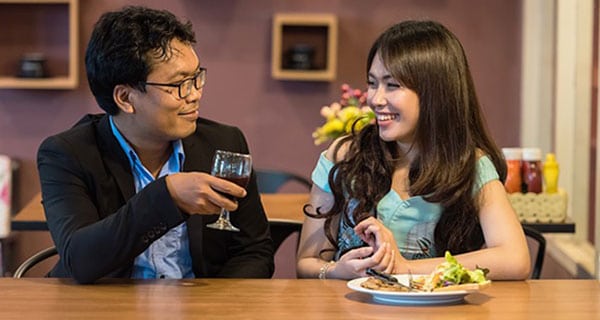 Humans are a special bunch – or at least we like to think we are. The truth is, our ‘success’ as a species, us big-brained, upright walking apes, isn’t all that unique. In fact, the success of all species comes down to a single shared evolved adaptation: the ability to convert organic material into energy.
Humans are a special bunch – or at least we like to think we are. The truth is, our ‘success’ as a species, us big-brained, upright walking apes, isn’t all that unique. In fact, the success of all species comes down to a single shared evolved adaptation: the ability to convert organic material into energy.
Simply, we and our cousin creatures survive on Earth because we’re good at finding and eating food.
Now, how humans do this is what makes us rather special. Our ancestors survived the eons of evolutionary change because we found and ate food by working intensely in groups. Our success is because we eat (and ate) together. Sharing food is our history.
But we’re slowly losing this history and with it a piece of our humanity.
We no longer share food as we once did. Nowhere is this more obvious than in the modern, tech-driven workplace. More than ever, people eat alone at their office desk.
Realizing just what’s at stake, companies are calling for a change.
Losing our history of food
President’s Choice began its mission to bring Canadians back to the table last year, with the launch of the #EatTogether movement. The movement left a mark on the public consciousness with the release of the company’s most recent ad. In the ad, we follow a young millennial woman growing up. Infant to toddler to teen, she engages in life’s little moments, all captured by the sharing of food with friends, family and loved ones. Flash to the present. The young woman sits at her office desk. Eyes fixed on the computer screen in front of her, headphone wires dangling by her side, she looks at the sandwich in her hand and it dawns on her: She’s eating alone and everyone around her is, too.
A recent national survey found that 66 per cent of working Canadians eat lunch alone at least three times in the work week. It’s the new normal, a conventional creation of the fast-paced workplace culture. Really, why would anyone eat together? That’s one hour of precious work time down the drain.
But this hyper-rationalizing perspective fails to account for the joyously complex, irrational nature of humans: We are an intensely social people formed out of the food-sharing cultural practices of old.
Sharing food and the four revolutions of humans
We are, according to experts, in the fourth major revolution of human history. Exploding technologies in advanced artificial intelligence are creating a world that sounds more like futuristic science fiction than real life. But what about our history? And where does food fit in?
First was the cognitive revolution around the time humans became humans. It was then that we evolved the brain capacity for spoken language. This created a peer-to-peer system to share knowledge about survival, about food: how to get it, how to prepare it, where to find it, etc. Finding (and eating) food became intensely social because of language.
Then came the agricultural revolution about 12,000 years ago. We stopped our erstwhile nomadic ways and settled down on the farm. We learned (together) how to more efficiently get our food through the planting and harvesting of crops. The collective food practices of agriculture created the first complex systems of human society.
Then the industrial revolution came. Food was taken out of the equation. Hydrocarbon and steam-powered technologies created the combustible engine. Smokestacks and fiery chimneys soon dotted city skylines. Raw materials like coal were commercialized, giving way to capitalism. It was the beginning of modern work. The purpose of the worker was to be kept busy. And for a little over 100 years, we’ve done just that: remained in a perpetual state of busyness (or business, as it was once spelled).
The future of work and eating together
And that brings us to the fourth revolution of today. Artificial intelligence and deep learning are the smokestacks of the 21st century. Things look different but productivity still hails supreme. Not unlike the industrial revolution, many of these newfangled technologies are meant to ‘improve’ how we do work, to ensure that things (and people) are as efficient as possible. These inventions bred the time-is-money culture, which normalized the idea that eating together at work is counterproductive and against busyness protocol.
But as we’ve learned from the earlier revolutions, food-sharing is our history. We’re genetically and culturally programmed to eat together. No amount of digital bells and whistles will change this. The more we design our modern workplace to align with our history of food-sharing, the better off we are.
Shifts in marketplaces and employee mentality suggest a growing recognition that organizations function best when people drop the hyper-productivity mindset and take breaks to eat together.
“As a company, we are integrating new technology on a daily basis, but we still believe in the ritual of gathering for lunch and dinner at the table,” says Sarah Davis, president of Loblaw Co. Ltd. “Our research shows that we build better relationships with our coworkers when we take time to disconnect from technology and enjoy lunch together. What a simple solution to fostering better relationships and creating a happier workplace … eating together just makes sense.”
Even Google, the techiest of big tech companies, believes in the benefits of eating together. Google’s AR/VR team is known for their quirky company rituals involving food. They don’t just break bread as a team. They bake it themselves – from scratch. “Eating together is an ingrained part of daily life at Google, whether that’s catching up over a coffee or sitting down to lunch as a group,” explains Sabrina Geremia, country manager, Google Canada. “Our food culture at Google is built around creating moments of connection that you just can’t get in a boardroom.”
Companies seeking competitive advantage would do well to heed the advice of President’s Choice to #EatTogether.
All employees, managers, executives and business owners with their eye on the latest innovations should think of this: Sometimes the best thing you can do for the company is to put down the tech and pick up a sandwich. Just remember to share the other half with a colleague.
Nick Hobson is a behavioural/brain scientist who consults individuals and organizations on peak performance in the workplace. He’s an expert on ritual, behaviour change, culture and emotions. He has published extensively in leading psychology and neuroscience journals, and lectures at the University of Toronto.
The views, opinions and positions expressed by columnists and contributors are the author’s alone. They do not inherently or expressly reflect the views, opinions and/or positions of our publication.

